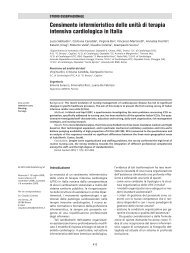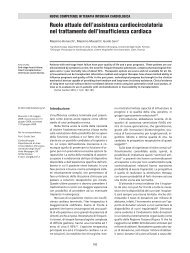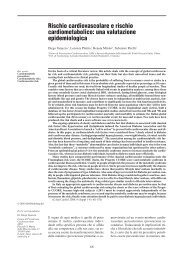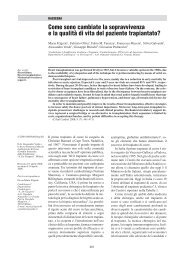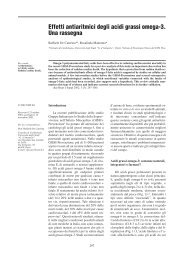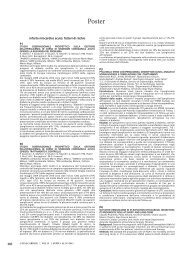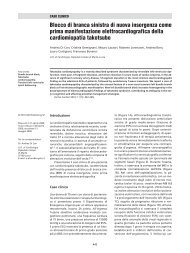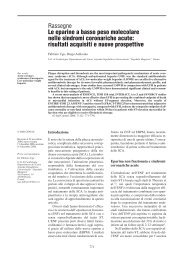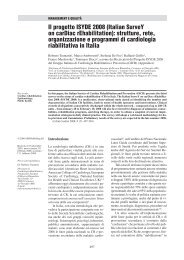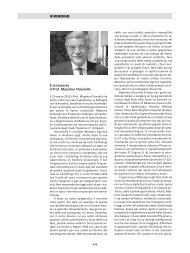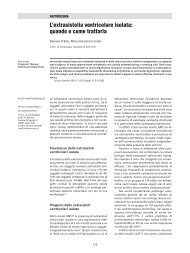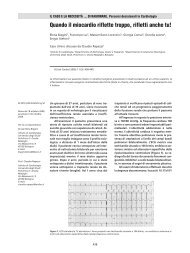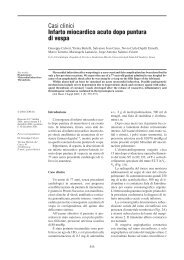Linee guida per la prevenzione, la diagnosi e il trattamento dell ...
Linee guida per la prevenzione, la diagnosi e il trattamento dell ...
Linee guida per la prevenzione, la diagnosi e il trattamento dell ...
Create successful ePaper yourself
Turn your PDF publications into a flip-book with our unique Google optimized e-Paper software.
G Ital Cardiol Vol 11 Suppl 2 al n 10 2010<br />
zione secondaria <strong>per</strong> ridurre <strong>il</strong> rischio di EI recidivante, ma tale<br />
opzione non è stata ancora valutata in maniera sistematica.<br />
In sintesi, nei pazienti con CC, l’EI è rara e colpisce più frequentemente<br />
le sezioni cardiache destre. La complessa anatomia<br />
rende difficoltosa <strong>la</strong> valutazione ecocardiografica. La prognosi<br />
è migliore rispetto alle altre forme di EI, con un’incidenza<br />
di mortalità 70 anni) si riscontra con sempre maggior frequenza<br />
e presenta <strong>dell</strong>e caratteristiche specifiche 372 . L’incidenza<br />
re<strong>la</strong>tiva di EI che colpisce <strong>il</strong> paziente anziano è risultata del<br />
26% nel<strong>la</strong> Euro Heart Survey 373 e <strong>il</strong> 33% dei pazienti era di età<br />
>67 anni nel registro francese 80 . Nelle indagini francesi l’incidenza<br />
di EI è andata aumentando tra <strong>il</strong> 1991 e <strong>il</strong> 1999 nei pazienti<br />
di età >50 anni, raggiungendo i 145 casi <strong>per</strong> m<strong>il</strong>ione nel<strong>la</strong><br />
c<strong>la</strong>sse di età compresa tra 70 e 80 anni 14 .<br />
Anche se non in modo univoco, precedenti report hanno<br />
dimostrato che l’EI in età avanzata è associata ad una prognosi<br />
sfavorevole e ad un’elevata incidenza di complicanze<br />
166,372,374,375 . Tale decorso clinico più severo è stato messo in re<strong>la</strong>zione<br />
al<strong>la</strong> sintomatologia insidiosa iniziale ed al ritardo nel<br />
porre <strong>la</strong> <strong>diagnosi</strong> nei soggetti anziani, così come ad un’incidenza<br />
più elevata di agenti patogeni maggiormente aggressivi in<br />
questa popo<strong>la</strong>zione 166,374,375 .<br />
Nell’anziano è stata riportata più frequentemente un’origine<br />
gastrointestinale <strong>dell</strong>’infezione. Gli streptococchi di gruppo<br />
D (S. bovis) rappresentano sempre più spesso <strong>la</strong> causa <strong>dell</strong>’EI, soprattutto<br />
nei pazienti anziani 208,376 , e sono risultati associati a<br />
neop<strong>la</strong>sie del colon, ad interessamento plurivalvo<strong>la</strong>re e ad elevato<br />
rischio embolico 208 . Anche l’EI enterococcica è stata osservata<br />
più frequentemente nei pazienti anziani 377 .<br />
La comparsa di febbre è meno usuale 374 , mentre gli stati<br />
anemici sono più diffusi, probab<strong>il</strong>mente <strong>per</strong> <strong>il</strong> maggior numero<br />
di EI da S. bovis, spesso caratterizzate da lesioni intestinali<br />
che possono provocare sanguinamento occulto 208 . In alcuni studi,<br />
le vegetazioni dei pazienti anziani sono risultate meno estese<br />
375 ed associate ad un rischio embolico più basso 372 . Di recente,<br />
le emocolture hanno dato esito negativo nel 16.7% dei pazienti<br />
anziani con EI 69 .<br />
Infine, nel<strong>la</strong> maggior parte degli ultimi studi l’età avanzata<br />
è risultata associata ad una prognosi sfavorevole 166,372,374,375 . So<strong>la</strong>mente<br />
pochi pazienti anziani vengono sottoposti a <strong>trattamento</strong><br />
chirurgico, verosim<strong>il</strong>mente a causa del più elevato rischio<br />
o<strong>per</strong>atorio corre<strong>la</strong>to all’età e alle frequenti comorb<strong>il</strong>ità<br />
378 . Ciononostante, <strong>il</strong> <strong>trattamento</strong> chirurgico sembra un’opzione<br />
ragionevole nell’anziano e presenta le stesse indicazioni<br />
di quelle previste <strong>per</strong> i pazienti più giovani 379 .<br />
Parte 6. Endocardite infettiva in gravidanza<br />
La mutevole fisiologia cardiovasco<strong>la</strong>re, che può simu<strong>la</strong>re una<br />
patologia cardiaca e confondere così <strong>il</strong> quadro clinico, rappresenta<br />
una sfida <strong>per</strong> <strong>il</strong> medico che deve valutare una paziente<br />
cardiopatica in stato di gravidanza 380,381 .<br />
L’incidenza di EI in gravidanza è stata riportata <strong>dell</strong>o<br />
0.006% 382 ; <strong>per</strong>tanto, l’EI è estremamente rara e può essere pro-<br />
e34<br />
vocata sia da una complicanza di lesioni cardiache preesistenti<br />
sia da una condizione di IVDA. La mortalità materna è quasi del<br />
33% e <strong>la</strong> maggior parte dei decessi è corre<strong>la</strong>ta a SC o ad eventi<br />
embolici, mentre <strong>la</strong> mortalità fetale è del 29% 382 . Partico<strong>la</strong>re<br />
attenzione deve essere posta alle donne in gravidanza che presentano<br />
febbre di origine sconosciuta o soffi cardiaci. Al fine di<br />
ridurre <strong>il</strong> rischio di mortalità materna e fetale, è importante<br />
identificare tempestivamente lo stato infettivo ed instaurare<br />
un adeguato <strong>trattamento</strong> 382 .<br />
M. Bibliografia<br />
1. More<strong>il</strong>lon P, Que YA. Infective endocarditis. Lancet 2004; 363:<br />
139-49.<br />
2. Habib G. Management of infective endocarditis. Heart 2006; 92:<br />
124-30.<br />
3. Horstkotte D, Fol<strong>la</strong>th F, Gutschik E, Lengyel M, Oto A, Pavie A, Soler-Soler<br />
J, Thiene G, von Graevenitz A, Priori SG, Garcia MA, B<strong>la</strong>nc<br />
JJ, Budaj A, Cowie M, Dean V, Deckers J, Fernandez Burgos E,<br />
Lekakis J, Lindahl B, Mazzotta G, Morais J, Oto A, Smiseth OA,<br />
Lekakis J, Vahanian A, De<strong>la</strong>haye F, Parkhomenko A, F<strong>il</strong>ipatos G,<br />
Aldershv<strong>il</strong>e J, Vardas P. Guidelines on prevention, <strong>diagnosi</strong>s and<br />
treatment of infective endocarditis executive summary; the task<br />
force on infective endocarditis of the European Society of Cardiology.<br />
Eur Heart J 2004; 25: 267-76.<br />
4. Naber CK, Erbel R, Baddour LM, Horstkotte D. New guidelines for<br />
infective endocarditis: a call for col<strong>la</strong>borative research. Int J Antimicrob<br />
Agents 2007; 29: 615-6.<br />
5. Moulds RF, Jeyasingham MS. Antibiotic prophy<strong>la</strong>xis against infective<br />
endocarditis: time to rethink. Med J Aust 2008; 189: 301-2.<br />
6. W<strong>il</strong>son W, Taubert KA, Gewitz M, Lockhart PB, Baddour LM, Levison<br />
M, Bolger A, Cabell CH, Takahashi M, Baltimore RS, Newburger<br />
JW, Strom BL, Tani LY, Gerber M, Bonow RO, Pal<strong>la</strong>sch T, Shulman<br />
ST, Rowley AH, Burns JC, Ferrieri P, Gardner T, Goff D, Durack DT.<br />
Prevention of infective endocarditis: guidelines from the American<br />
Heart Association: a guideline from the American Heart Association<br />
Rheumatic Fever, Endocarditis, and Kawasaki Disease Committee,<br />
Counc<strong>il</strong> on Cardiovascu<strong>la</strong>r Disease in the Young, and the<br />
Counc<strong>il</strong> on Clinical Cardiology, Counc<strong>il</strong> on Cardiovascu<strong>la</strong>r Surgery<br />
and Anesthesia, and the Quality of Care and Outcomes Research<br />
Interdisciplinary Working Group. Circu<strong>la</strong>tion 2007; 116: 1736-54.<br />
7. Baddour LM, W<strong>il</strong>son WR, Bayer AS, Fowler VG Jr, Bolger AF, Levison<br />
ME, Ferrieri P, Gerber MA, Tani LY, Gewitz MH, Tong DC, Steckelberg<br />
JM, Baltimore RS, Shulman ST, Burns JC, Fa<strong>la</strong>ce DA, Newburger<br />
JW, Pal<strong>la</strong>sch TJ, Takahashi M, Taubert KA. Infective endocarditis:<br />
<strong>diagnosi</strong>s, antimicrobial therapy, and management of<br />
complications: a statement for healthcare professionals from the<br />
Committee on Rheumatic Fever, Endocarditis, and Kawasaki Disease,<br />
Counc<strong>il</strong> on Cardiovascu<strong>la</strong>r Disease in the Young, and the<br />
Counc<strong>il</strong>s on Clinical Cardiology, Stroke, and Cardiovascu<strong>la</strong>r Surgery<br />
and Anesthesia, American Heart Association: endorsed by the Infectious<br />
Diseases Society of America. Circu<strong>la</strong>tion 2005; 111: e394e434.<br />
8. Nishimura RA, Carabello BA, Faxon DP, Freed MD, Lytle BW, O’-<br />
Gara PT, O’Rourke RA, Shah PM. ACC/AHA 2008 Guideline Update<br />
on Valvu<strong>la</strong>r Heart Disease: Focused Update on Infective Endocarditis.<br />
A Report of the American College of Cardiology/American<br />
Heart Association Task Force on Practice Guidelines. Circu<strong>la</strong>tion<br />
2008; 118: 887-96.<br />
9. Danchin N, Duval X, Leport C. Prophy<strong>la</strong>xis of infective endocarditis:<br />
French recommendations 2002. Heart 2005; 91: 715-8.<br />
10. Gould FK, Elliott TS, Foweraker J, Fulford M, Perry JD, Roberts GJ,<br />
Sandoe JA, Watkin RW, Working Party of the British Society for<br />
Antimicrobial C. Guidelines for the prevention of endocarditis: report<br />
of the Working Party of the British Society for Antimicrobial<br />
Chemotherapy. J Antimicrob Chemother 2006; 57: 1035-42.



